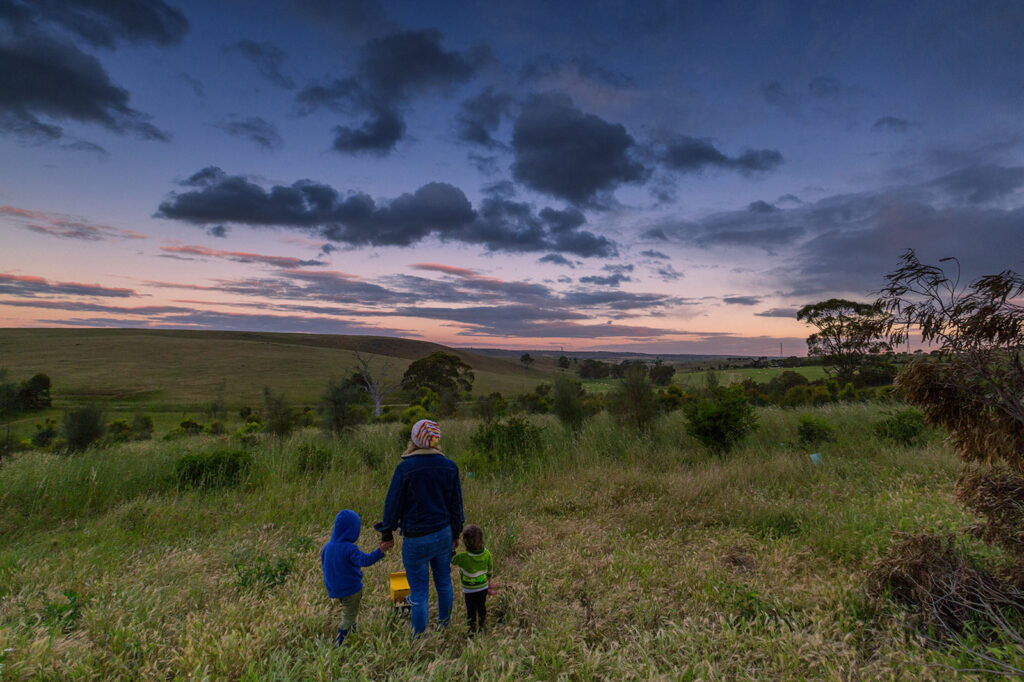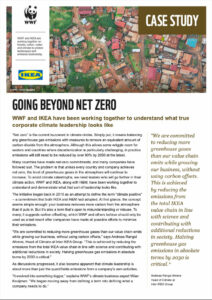Going beyond net zero
WWF and IKEA have been working together to understand what true corporate climate leadership looks like
“Net zero” is the current buzzword in climate circles. Simply put, it means balancing any greenhouse gas emissions with measures to remove an equivalent amount of carbon dioxide from the atmosphere. Although this allows some wriggle room for sectors and countries where decarbonization is particularly challenging, in practice emissions will still need to be reduced by over 90% by 2050 at the latest.
Many countries have made net-zero commitments, and many companies have followed suit. The problem is that unless every country and company achieves net zero, the level of greenhouse gases in the atmosphere will continue to increase. To avoid climate catastrophe, we need leaders who will go further in their climate action. WWF and IKEA, along with H&M, have been working together to understand and demonstrate what that sort of leadership looks like.
The initiative began back in 2019 as an attempt to define the term “climate positive” – a commitment that both IKEA and H&M had adopted. At first glance, the concept seems simple enough: your business removes more carbon from the atmosphere than it puts in. But it’s also a term that’s open to misunderstanding or misuse. To many, it suggests carbon offsetting, which WWF and others believe should only be used as a last resort after companies have made all possible efforts to minimize their emissions.
“We are committed to reducing more greenhouse gases than our value chain emits while growing our business, without using carbon offsets,” says Andreas Rangel Ahrens, Head of Climate at Inter IKEA Group. “This is achieved by reducing the emissions from the total IKEA value chain in line with science and contributing with additional reductions in society. Halving greenhouse gas emissions in absolute terms by 2030 is critical.”
As discussions progressed, it also became apparent that climate leadership is about more than just the quantifiable emissions from a company’s own activities.
“It evolved into something bigger,” explains WWF’s climate business expert Milan Kooijman. “We began moving away from defining a term into defining what a company needs to do.”
Much of the groundwork for this is already in place. The Science- Based Targets initiative has released a net-zero standard to support companies to reduce their emissions in line with what science demands. WWF’s own blueprint for corporate action on climate and nature complements this by outlining how companies can take a more holistic approach to climate mitigation, including through investing in nature-based solutions (reducing emissions through actions to protect and restore ecosystems like forests).
“The Science-Based Targets initiative and others are doing an excellent job of making credible net-zero commitments the norm,” says Milan. “But a leading climate company cannot stop there. We need to go beyond net-zero, to go beyond just looking at emissions to look at the influence and power that companies have, and how they can help others to become more sustainable too.”
IKEA is starting to see real results from its climate mitigation actions – from supporting suppliers in the switch to 100% renewable energy to introducing more plant-based choices in its restaurants – but more needs to be done.
“We want to show what corporate leadership looks like, both when it comes to reducing emissions across our value chain, but also in terms of the policies companies should be advocating for,” says Andreas.
“We started looking at extended responsibility within our own supply chains. For instance, we might be using only a small part of a supplier’s factory, but we can push them to reduce emissions across their operations – including what they manufacture for other companies. We’re also looking towards our customers – not just the products we sell to them, but things they can do at home to reduce their own emissions, such as generating renewable electricity through solar panels.”

© Didi Photos / WWF-Australia
Walking the walk
The collaboration between WWF, IKEA and H&M resulted in the release in April 2022 of Beyond Net- Zero: A business pathway to spur urgent climate action towards 2030. This outlines seven actions that companies should take to tackle the climate crisis. Along with delivering on ambitious net-zero targets – including halving emissions by 2030 – these include financing nature-based solutions, engaging actively in climate policy, collaborating with value chain partners and inspiring customers.
As well as a list of concrete actions, the guidance includes metrics, practical advice and best practices to help companies implement them.
It’s this practical aspect that the Beyond Net-Zero project aims to build on in the coming months and years, by sharing case studies, advice and challenges.
“The reaction to the Beyond-Net Zero launch has been very positive,” says Andreas. “There’s lots of interest and appetite to continue. People want to know how to do this in practice.”
“Businesses like IKEA and H&M are stepping up their actions and approaches to be in line with their own targets and strategies,” says Milan. “The time for celebrating great ambitions is over. Words needs to be followed up with the right actions, or you’re basically greenwashing. But that also means being honest about the challenges and what you as a company are struggling with.”
Working in partnership has been a key strength of the project. “If WWF just comes out on its own and says ‘this is what companies should do,’ many of them will say it’s unrealistic,” says Milan. “But with two ambitious corporates like IKEA and H&M on board, it’s has far more credibility. In fact, they’ve pushed us to be even bolder than we would have been if we had done this alone.”
Equally, according to Andreas, working with WWF increases credibility for IKEA: “It’s about taking a science-based approach. We want WWF to challenge us, to act as our conscience and to push us to do the best we can.”
Beyond Net-Zero Case Study
In this case study, IKEA Group’s Andreas Rangel Ahrens and Charlotte Glassco explain how they’re delivering on Beyond-Net Zero’s fifth leadership action – policy engagement. In addition to English, the guidance is also now available in French and Spanish.
For more information
Milan Kooijman
WWF Climate Business Expert
Milan.Kooijman@wwf.se
Lessons learnt:
Corporate climate action
Success factors:
Don’t replicate, elevate: The project aims to complement and build on the most credible existing tools, like the Science-Based Targets initiative’s net-zero standard.
Quality, not just quantity: As well as measuring carbon emissions, it’s important not to miss out on equally important actions where the impact is harder to quantify – like advocating for public policy changes or supporting climate resilience and adaptation.
Trust and transparency: Openness and honesty, particularly around the most difficult challenges, have been key to the smooth running of the Beyond Net-Zero process – helped by the longstanding partnerships between WWF and IKEA/H&M.
Ongoing challenges:
Practical examples: The project’s focus now is on collecting and sharing examples of good practices and solutions among businesses committed to ambitious action.
We are committed to reducing more greenhouse gases than our value chain emits while growing our business, without using carbon offsets. This is achieved by reducing the emissions from the total IKEA value chain in line with science and contributing with additional reductions in society. Halving greenhouse gas emissions in absolute terms by 2030 is critical.
– ANDREAS RANGEL AHRENS, Head of Climate, IKEA
